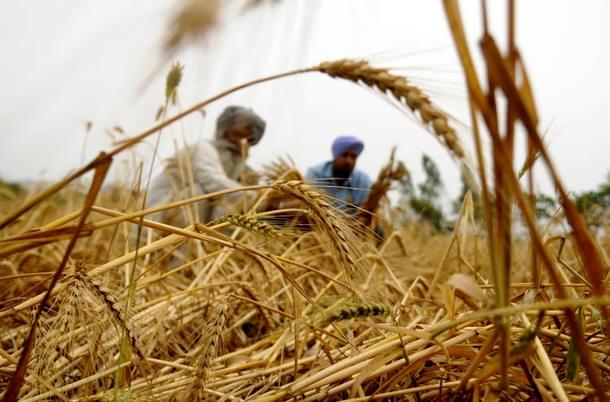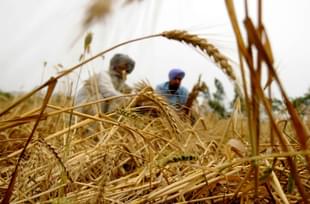Economy
India Is Set To Harvest Record Wheat Crop This Year, But There’s Not-So-Good News
M R Subramani
Mar 16, 2020, 05:03 PM | Updated 05:04 PM IST
Save & read from anywhere!
Bookmark stories for easy access on any device or the Swarajya app.


Over the last 10-15 days, rains have lashed many parts of north India with reports saying the standing wheat crop is being affected by the downpour.
However, production of wheat may not be affected as feared. Probably, the quality of the grains in the rain-hit areas could be affected. But there is a more worrisome issue of bulging stocks.
The Economic Times quoted Dr Gynanedra P Singh, Director, Indian Institute of Wheat and Barley Research, as saying that there could be loss of up to five per cent of the crop.
In India, wheat is grown during the winter or rabi season. The crop is sown during November-December and harvested around April. In parts of Gujarat and Madhya Pradesh, the crop is sown a little early and the harvest is either due or already on.
According to Ministry of Agriculture data, wheat has been sown on 33.61 million hectares (mh) during the rabi season this year, up by over four mh from last year. It is also 3.1 mh higher than the normal area under the crop.
Despite the rains in the last fortnight, the weather for the wheat crop has been conducive this year. Weather in the growing areas continues to be cool and it could lead to a good harvest. This could result in production touching a new record this year.
Last year, wheat production was a record 102.19 million tonnes (mt). This year, the output could top 110 mt, according to industry sources. The record production will only leave the government with a tough task for a couple of reasons.
One, last year’s record production has forced the country to carryover record wheat stocks to the coming rabi marketing season starting April.
According to data from the Food Corporation of India (FCI), wheat stocks were 27.52 mt as on 1 March. This is far higher than the mandatory stocks of 7.46 mt the country should have as on 1 April.
According to the statutory norms fixed by the government, the FCI should have 4.46 mt of operational wheat stock and three mt of strategic reserve that can come handy during famine or other such food emergencies.
On top of the record stocks, if India harvests a record wheat crop, estimated around 110 mt now, it could lead to the country grappling with mountains of wheat stocks.
India will be sitting on a whopping 136 mt of wheat stocks. A worrying factor is that these stocks would be stored in traditional warehouses where there can be losses due to flooding, weather, insects and rodents.
Second, wheat offtake by the States for distribution through the rations shops is slack. According to FCI data, the offtake of wheat under various schemes till October last year was only 14.41 mt with 13.01 mt going towards National Food Act Scheme.
Under the scheme, wheat is distributed at a subsidised rate to the poor or below poverty line people. However, industry sources say that most of the wheat meant to be distributed to the poor find its way into the open market.
The record wheat stocks with the FCI is despite the offtake under various welfare schemes being around 26 million tonnes annually. Ironically, while the FCI holds huge stocks, the flour millers are scouring for stocks to meet their raw material demand.
The FCI comes up with Open Market Sale Scheme (OMSS) quite often, but since the buyer has to pay the corporation’s carrying costs, there are few takers. Until October, only six lakh tonnes were sold under OMSS when FCI could have sold more.
A view gathering strength among wheat users is that there has to be a paradigm shift in the government’s objective in wheat production.
Till now, the policy is to be self-sufficient, which has been achieved long ago. It has to shift to find various uses for the wheat produced in the country and increase its consumption.
For example, the policymakers have to review the policy of adding FCI carrying costs under OMSS. The corporation incurs a carrying cost of Rs 3,500 per tonne for wheat that was bought at Rs 18,400 a tonne last April.
This year, the minimum support price for wheat has been raised to Rs 19,250 a tonne and this will force the government to spend more towards procuring stocks for its operational stock and strategic reserve.
Also, if the government doesn’t procure the wheat from the growers, it could result in prices crashing and lead to distress sales, something any government cannot afford as it would be political suicide.
In addition to carrying costs — interest plus storage charges — the government also pays various cesses for buying wheat from the growers to the state governments. These costs add up an additional 15 per cent to the procurement costs.
The higher OMMS costs result in consumers paying a higher price for wheat flour or atta in retail outlets. In the end, the government, the industry and the consumer all end up spending more than they need to.
In September last year, the Food Ministry, which supervises the functioning of the FCI, was advised by the Prime Minister’s Office (PMO) to cut the OMSS price but it was ignored.
Had the Food Ministry officials listened to the PMO’s suggestions, it could have cut the carrying stocks in many ways. One, flour mills could have bought more from the FCI than from private trading firms, which also provide a good credit limit.
Two, the poultry industry was struggling in view of zooming maize (corn) prices. A lower wheat price would have given the poultry industry the option of using it as a feed and thus cut the stocks to some extent.
Users had to urge the government to allow them to import maize duty-free in view of the high prices. The government allowed the users to import feed-grade maize at a concessional 15 per cent duty.
Maize prices have dropped 15 per cent since January on the back of a higher production in the Kharif or summer sowing season. But when maize prices were ruling over Rs 27 a kg, a wheat price lower than Rs 25 could have helped a lot.
Wheat exports, at current MSP, are unfeasible. Indian wheat is mainly looked up as feed grade and when quality wheat is quoted at least $100 tonne cheaper than Indian prices, chances are bleak.
All these leave the government facing a tough option of holding huge wheat stocks. Sooner or later, it will have to look at various other options to cut them, mainly to cut carrying costs that are over Rs 13,000 crore a year.
Besides wheat, the rains have also hit mustard and potato crops, but the damage is yet to be assessed.
M.R. Subramani is Executive Editor, Swarajya. He tweets @mrsubramani





